Isotria Raf. (Orchidaceae)
Isotria (Orchidaceae) is represented by two species worldwide, both of which are eastern
North American in distribution and both of which occur in North Carolina. The genus comprises the only North American orchid species exhibiting whorled leaves terminating the stem. Isotria medeloides (Pursh) Raf. is federally listed (Fed T, S1 G2G3). The other taxon—I. verticillata(Muhl. ex Willd.) Raf.—is neither listed nor proposed for listing.
Federally listed taxon—
Isotria medeoloides (Fed T, State T | S1 G2G3)
Habitat. Usually montane oak-hickory or acidic cove forests, from 2000 to 4000 ft elev.
Range. Eastern North America from Georgia to Canada.
Additional resources. NHP | Recovery plan | 5-year review
Key to Isotria
Key adapted from Mehrhoff and Homoya (2002 [FNA]) and Weakley (2008).
Line illustrations from the public domain Britton & Brown (1913), unless otherwise
indicated. Maps courtesy of USDA PLANTS and the North Carolina Natural Heritage Program.
1. Sepals relatively short (12–30 mm long), greenish-brown; lip 10–15 mm long; fruiting pedicel (0–) 5–10 (–15) mm long; plant glaucous, stems whitish-green...I. medeoloides* 
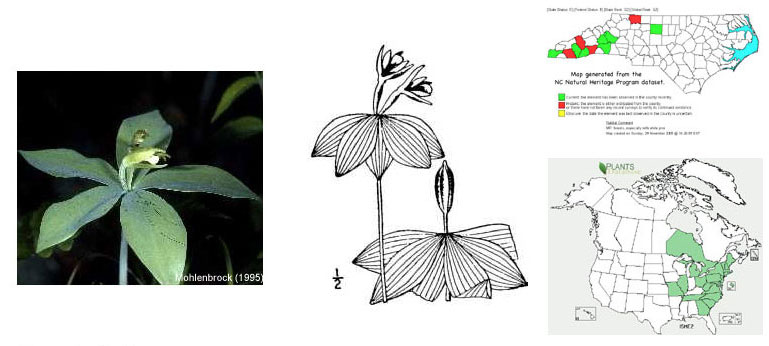

Habit of Isotria medeoloides (Photo: Krings)

Habit of Isotria medeoloides (Photo: Krings)

Isotria medeoloides (Photo: Krings)

Stem of Isotria medeoloides (Photo: Krings)

Isotria medeoloides inflorescence (Photo: Krings)

Isotria medeoloides (Photo: Krings)

Isotria medeoloides (Photo: Krings)
Isotria medeoloides*
(rare [Fed T, S1 G2G3]; moist forests, often with
Pinus strobus; Mt, Pd; spring to early summer)
1’. Sepals long (35–60 mm long), purple-brown; lip 20–25 mm long; fruiting pedicel (12–) 20–55 mm long; plant not glaucous or only scarcely so, stems generally purplish...I. verticillata 


Habit of Isotria verticillata (Photo: Haug)

Habit of Isotria verticillata (Photo: McMillian)

Habit of Isotria verticillata (Photo: McMillian)

Habit of Isotria verticillata (Photo: McMillian)

Habit of Isotria verticillata (Photo: Haug)

Habit of Isotria verticillata (Photo: McMillian)

Flower of Isotria verticillata (Note the long sepals; Photo: Barnes)
Isotria verticillata
(uncommon; moist to dry forests; Mt, Pd, CP)
Similar Species
Sterile individuals of Isotria may at a glance resemble young Medeola virginiana, Lysimachia quadrifolia, Lilium spp., or Coreopsis major. The following key distinguishes among these:
1. Leaf venation pinnate...2.
2. Nodes and leaves (at least midrib) stipitate glandular; leaves whorled...Lysimachia quadrifolia (Primulaceae) 
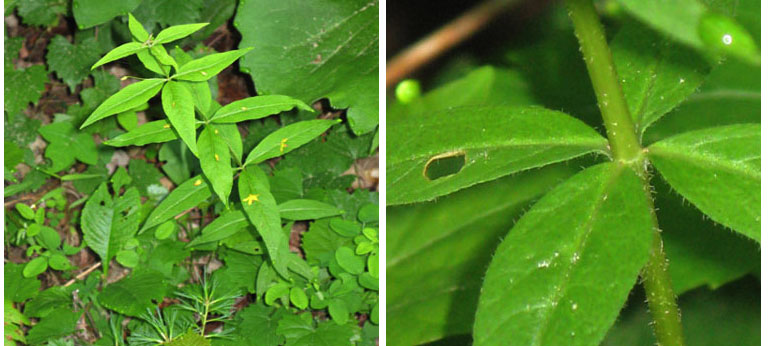 Lysimachia quadrifolia
Lysimachia quadrifolia (Photo: Krings)
2’. Nodes and leaves glabrous, or at least not stipitate glandular; leaves appearing whorled, but in opposing sets of two or more...Coreopsis major (Asteraceae) 
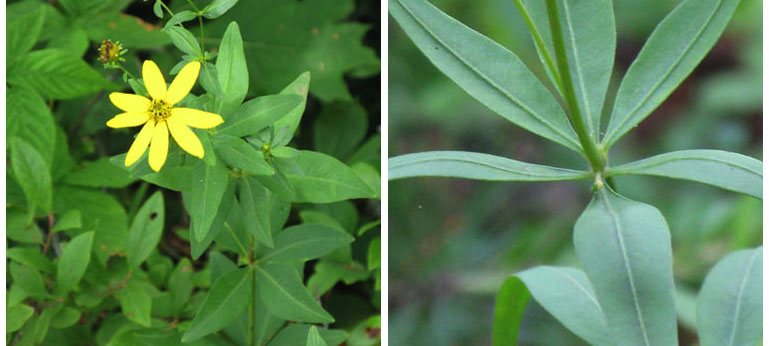 Coreopsis major
Coreopsis major (Photo: Krings)
1’. Leaf venation parallel...3.
3. Stems wiry, floccose at least toward the base or throughout...Medeola virginiana (Liliaceae) 
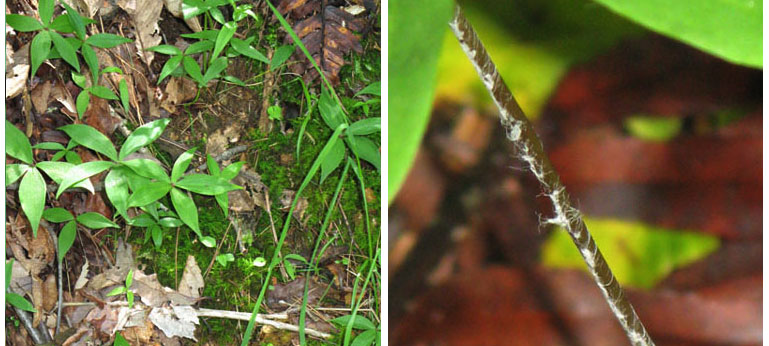 Medeola virginiana
Medeola virginiana (Photo: Krings)
When juvenile,
Medeola virginiana displays only a single whorl of leaves terminating the stem (see left image above) and thus could be easily mistaken for
Isotria medeoloides, unless a closer look is taken at the stem. Stems of
Medeola virginiana are not glaucous and usually exhibit floccose hairs (see right image above). Stems of
Isotria medeoloides, in contrast, are glaucous and glabrous.
3’. Stems fleshy, glabrous...4.
4. Lowermost leaf or leaves on stem simple, alternate...Lilium spp. (Liliaceae) 
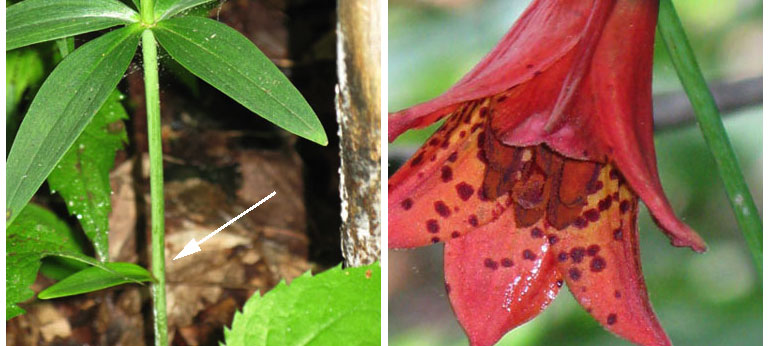 Lilium grayi
Lilium grayi (Photo: Krings)
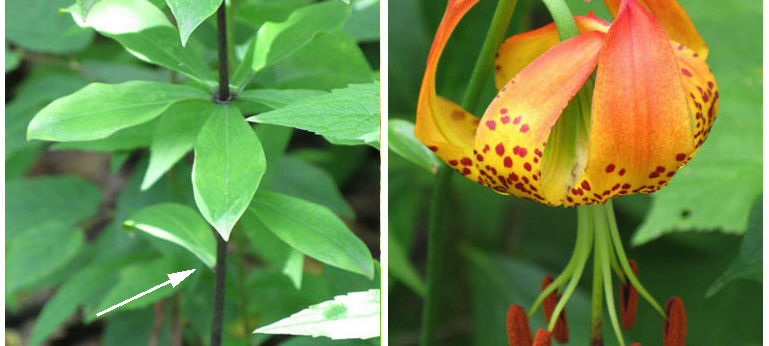 Lilium michauxii
Lilium michauxii (Photo: Krings)
4’. All leaves borne in a single whorl [Isotria]...5.
5. Sepals 12–30 mm long, greenish-brown; lip 10–15 mm long; fruiting pedicel (0–) 5–10 (–15) mm long; plant glaucous, stems whitish-green...Isotria medeoloides* 
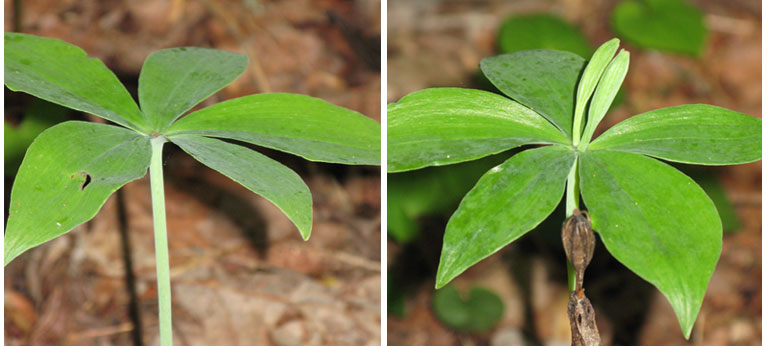 Isotria medeoloides*
Isotria medeoloides* (Photo: Krings)
5’. Sepals 35–60 mm long, purple-brown; lip 20–25 mm long; fruiting pedicel (12–) 20–55 mm long; plant not glaucous or only scarcely so, stems generally purplish...Isotria verticillata 
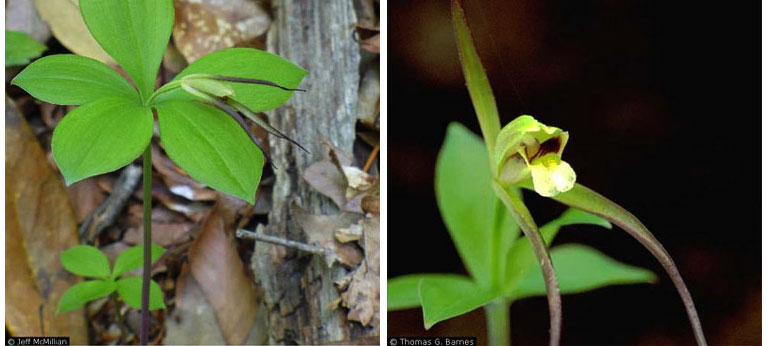 Isotria verticillata
Isotria verticillata (Photo: McMillian [left], Barnes [right])








